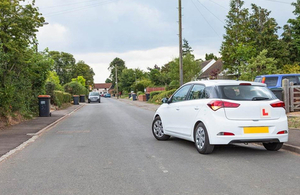DVSA response to media reports about decade-low driving test pass rate
The Driver and Vehicle Standards Agency (DVSA) has rebutted claims that the driving test pass rate is at a decade-low because of a 'dangerous' manoeuvre.

Reports in the media on 20 and 21 July 2019 claim that the current driving test pass rate of 45.8% has been caused by a ‘dangerous new manoeuvre’.
However, this is not correct. Learner drivers make fewer serious and dangerous faults on the ‘pull up on the right’ manoeuvre, compared to other reversing manoeuvres.
On 17 July 2019, DVSA revealed that the top reasons for failing the driving test are actually failing to look properly at junctions, and not using mirrors effectively when changing direction.
Mark Winn, DVSA’s Chief Driving Examiner, said:
DVSA’s priority is to help everyone through a lifetime of safe driving.
Candidates should only attempt their test when they’ve gained a broad range of experience and are ready to drive safely and independently.
Anyone who fails their driving test has to wait at least 10 working days to take another. This ensures the candidate has time to undergo additional training and improve any faults noted by the examiner before they take their test again.
Find out more about the 10 top reasons learner drivers have failed the new test.
Why the new manoeuvre was introduced
The new manoeuvre was introduced into the driving test on 4 December 2017, as part of a package of updates to make the test more reflective of real-life driving.
The learner driver has to pull up on the right-hand side of the road, reverse for around 2 car lengths, and then rejoin the traffic.
DVSA does not recommend that drivers always pull up on the right. Best practice is to pull up on the left. This is still what DVSA expects new drivers to be taught.
Making sure new drivers can do the manoeuvre safely
However, the reality is that it’s not always possible to pull up on the left. So, as well as being taught that it’s best practice to pull up on the left, DVSA wants to make sure new drivers:
- know what factors to take into account when they decide whether or not to pull up on the right
- are trained to carry out the manoeuvre safely in appropriate places
It’s far safer for new drivers to be taught this legal manoeuvre by a driving instructor, rather than leaving it to chance once they’ve passed their test.
How DVSA checked the manoeuvre is safe before it was introduced
Before the manoeuvre was introduced to the test, it was trialled across Great Britain.
It was also subject to a risk assessment by DVSA, and an independent risk assessment by the Royal Society for the Prevention of Accidents (RoSPA). Both assessments showed it’s a low-risk manoeuvre.
DVSA also provided guidance to driving instructors about carrying out the manoeuvre.